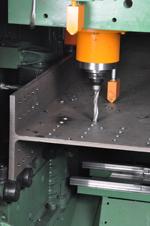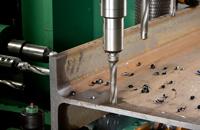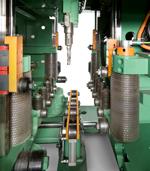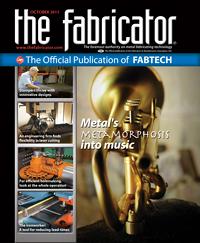Vice President of Marketing
- FMA
- The Fabricator
- FABTECH
- Canadian Metalworking
Categories
- Additive Manufacturing
- Aluminum Welding
- Arc Welding
- Assembly and Joining
- Automation and Robotics
- Bending and Forming
- Consumables
- Cutting and Weld Prep
- Electric Vehicles
- En Español
- Finishing
- Hydroforming
- Laser Cutting
- Laser Welding
- Machining
- Manufacturing Software
- Materials Handling
- Metals/Materials
- Oxyfuel Cutting
- Plasma Cutting
- Power Tools
- Punching and Other Holemaking
- Roll Forming
- Safety
- Sawing
- Shearing
- Shop Management
- Testing and Measuring
- Tube and Pipe Fabrication
- Tube and Pipe Production
- Waterjet Cutting
Industry Directory
Webcasts
Podcasts
FAB 40
Advertise
Subscribe
Account Login
Search
A holistic view of holemaking
Maximizing drill-line throughput requires a comprehensive approach
- By Nick Hajewski
- October 20, 2011
- Article
- Materials Handling

Figure 1: Shown just behind the drill, a hold-down clamp dampens web vibration and applies force to eliminate the potential for premature tool failure.
When drill lines aren’t performing to expectations, they starve downstream operations. Work flow slows; profits are lost.
Drill lines are the backbone of any modern structural fabricator. When processed sections are not exiting the machine, other operations effectively are paralyzed. A tool can fail if material isn’t adequately clamped; an unexpected deviation in material can wreak havoc on carbide tooling; or the machine simply may be lacking material to perform the job because of old-fashioned handling methods. Each of these scenarios equates to machines sitting idle and valuable overhead being wasted.
If a drill line doesn’t deliver parts at the correct time, the operation stops and lost time mounts. To that end, structural fabricators must ensure that their drill lines are robust enough to properly support the aggressive speeds and feeds of modern tooling. At the same time, shop layout and material handling strategies must ensure no drill line sits idle for excessive periods, just waiting for that next piece of material.
Carbide Basics
Carbide tooling has long served the precision machining markets. Manufacturers that have relied upon traditional machining centers, with their stop-and-fixture methods of production, are familiar with the benefits that carbide can offer. Its high melting point and impressive hardness make carbide the ideal tooling choice when high drilling speeds and feeds are required. Carbide tools prove to consistently drill more than twice as fast as traditional high-speed steel (HSS) or twist-drill tooling.
What is old news in other sectors is new again for the structural business, which only recently started making significant use of carbide tooling. This is because of the nuances associated with properly applying carbide tooling to the structural fabricator’s material of choice: hot-rolled mild steel sections. Rolled shapes such as beams, channels, square or rectangular tubes, and angle iron are commonly processed in a pass-through procedure. The increased feed and RPM of a carbide drill spindle can create unwanted material vibration and flex that might damage carbide tooling in an environment not known for stop-and-fixture methods.
Although harder than traditional twist-drill or HSS tooling, carbide is much more brittle and thus more susceptible to damage when unwanted material vibration or motion is present. Advances in machine design enhance workpiece rigidity and manage chip load, all while sustaining traditional pass-through production methods. Such technology has ensured carbide’s newfound success in structural fabrication.
Clamping for Carbide
Today’s drilling machines are designed to handle carbide tooling (see Figure 1 and Figure 2). The comprehensive clamping systems not only ensure optimal tool life, but also allow drilling machines to push harder and drill faster. Compared to machines that are designed to apply HSS or twist drills, contemporary carbide drilling machines have far more vertical clamps, datum rollers, passline rollers, and clamping force than their predecessors. Where two vertical hold-down clamps used to be acceptable, four are now the standard. Web probes that previously located only the material surface now also serve as a web clamp to hold material rigid and dampen workpiece vibration.
Modern hold-down clamps keep flanges rigid despite the aggressive feed of carbide spindle assemblies. For machines designed to process extra-wide profiles, an underside support system helps eliminate the materials’ inherent tendency to spring backward upon hole completion.
Drilling Feedback
Carbide tooling requires consistent chip load to achieve optimal tool life. When chip load is too heavy or too light, the tooling is susceptible to damage or premature failure. This is why modern spindle motors send information back to the controller in real time to ensure the spindle RPM matches programmed feed rates.
Spindle feedback is not as critical when using HSS or twist-drill tooling. In these applications spindle motors simply apply the amount of power needed to meet the desired speed in ideal situations. When hard spots are encountered, the spindle is allowed to slow down both its feed and speed to accommodate fluctuations in material quality. Although the less brittle HSS and twist-drill tools can accept those fluctuating speeds and feeds, such variability isn’t ideal for carbide tools.
This is why carbide drilling benefits from “intelligent” spindle motors that maintain preprogrammed speeds and feeds, adjust to material hard or soft spots, and sense hole completion. The spindles’ internal encoders monitor the exact speed and rotation of the drill. If the tool encounters hard spots, the motor adapts by applying additional torque to maintain its preprogrammed speed, regardless of the hardness or tensile qualities of the material being processed. This, combined with a precision feed, ensures optimal chip load in spite of material qualities. Because the system monitors torque, it senses the exact moment it completes the drilling cycle, stops the spindle feed, and immediately retracts and proceeds to the next hole in a program. This eliminates unnecessary and time-consuming “drilling of air” between operations.
Tool Lubrication
In a modern drill line, minimum quantity lubrication (MQL)—using an ecofriendly vegetable oil-based form of tool lubrication—is delivered through the tool directly to the cutting surface, as was the case in the past with water and chemical mixtures. But unlike those traditional methods, MQL usually applies only one drop every three to four seconds.
This “near dry” form of drill lubrication not only eliminates the need to continually clean profiles postprocessing, it also minimizes maintenance and mess. Less maintenance means less downtime, which also means more profiles are exiting the drilling machine and moving on to the next procedure.
More Tools, Automatic Tool Changers
These days structural fabricators process a wide range of projects, and this has made multitool operations commonplace (see Figure 3). Fabricating these projects on a traditional three-spindle drill may require more manual tool changes and repetitive processing of a single piece to achieve finished parts.
Modern multitool designs eliminate manual tool changeout. Nine-spindle and multistation tool-changer designs permit continuous production of complex parts with a diverse range of hole sizes or operations, including tapping and countersinking. Each axis of drilling can be loaded with tooling, ready to drill upon program command. Many structural parts commonly have up to three hole sizes per surface, so having three tool sizes available in each of the drilling axes can speed operations greatly.
For applications with up to five hole diameters per drilling surface, tool-changer systems use a tool rack stationed near the drilling assembly. The rack holds all of the tools needed for production requirements. Upon program command, the drill spindle unloads its current tool into the rack and makes the next selection automatically. Throughout the process, operators remain safely outside of the machine.
Modern Measurement Technology
Clamping the material once it reaches the drill’s operating area is vital, but break-neck drilling speeds can be stifled if the material isn’t measured efficiently as well. To that end, certain systems offer a precision roller wheel with an encoder that sends material-feed information to the controller. The wheel remains in a safe position where material enters the drilling machine. As material enters, the roller wheel presses against the material surface. The encoder counts the wheel revolutions in relation to the travel of material. A spring-loaded mechanism ensures that the wheel stays in constant contact with the material and remains unaffected by rust or scale (see Figure 4).
These automatically adjust to a profile’s most true location to accommodate tight tolerances. The machine logic references an internal shape library that designates the proper place to measure on the material. For beams this means that measurement occurs in line with the location of the web. For channels and angles, measurement occurs at the heel; and for square or rectangular tubing, measurement occurs at the material’s center. Because the measurement occurs at the drilling machine entry and not at a secondary piece of equipment that traverses the conveyor, workpieces can be fed into the drill line one after another without needing to wait for secondary devices.
Because no clamp or gripper is involved with material handling, there is no need to switch out components when changing over from large to small material, or vice versa. The feed system also eliminates restrictions on overall material length. The only feeding restriction is maximum weight, which is commonly based on the heaviest rolled section for the machine’s specification.
The Fast Lane
No matter how fast drill lines become, they will not show their full potential if they sit idle, waiting for material. Efficient material handling designs eliminate unnecessary crane lifting, while also increasing overall throughput capacity.

Figure 3: Multitool drill lines, such as this nine-spindle system, eliminate downtime and secondary operations for workpieces with multiple hole sizes or operations.
In a structural fabrication facility, material handling equipment consumes most of the area required to accommodate machinery—and this under-roof space does not come cheap. Maintaining a large indoor facility creates significant overhead, including heating and electrical costs, initial investment, and property taxes.
This is why some structural fabricators now place machines in smaller outbuildings or garages (see Figure 5). Material handling occurs outside, as fork trucks or dedicated outside crane-ways place beams on powered conveyors that carry material into the outbuildings. After cutting and drilling, beams and plates move to the main welding and fabrication garages for completion.
The arrangement allows a fabricator to allocate minimal overhead costs for the simple task of transferring material from one station to another.
It also minimizes crane-way traffic so that drill lines and other machines spend less time waiting for material.
Inside the outbuildings operators control all material handling via dedicated controls. As material passes through the machine, it simultaneously passes through the smaller outbuilding as well, and upon completion is transferred outside to another building for the next process, be it coping and sawing or fit-up and welding.
Ensuring Accurate Information
Multiple functions on these machines make them “all-in-one” production systems that meet the demands of complex commercial, manufacturing, or industrial projects. Modern drilling machines can scribe layout markings for connections (see Figure 6), which can expedite welding and fit-up operations.
Programming now can be directly linked to comprehensive, 3-D building information modeling (BIM) systems.
This ensures information is pulled from the original building design and is translated precisely into data-rich CNC programs.
The Big Picture for Part Production
Many carbide drilling operations can finish workpieces quickly and make as many as 1,800 to 2,000 holes per carbide insert. This all has serious benefits in today’s competitive structural fabrication market.
Still, the efficiency and consistency of drilling—or any operation, for that matter—cannot be measured apart from the processes that surround it. Fast drilling does not mean much if a machine doesn’t offer fast feeding and clamping; or if workers spend excessive time changing tools; or if a drill line sits idle for long periods, waiting for material.
Structural fabricators have found success taking a holistic view. It’s not just about how fast one machine runs; it’s also about how that fast machine integrates with the rest of the operation, shortening not only drilling but also overall manufacturing time. This reduces overhead, frees up cash, and ultimately leads to greater profits.
About the Author
Nick Hajewski
300 N. Washington Ave.
Bradley, IL 60915
815-937-3800
Related Companies
subscribe now

The Fabricator is North America's leading magazine for the metal forming and fabricating industry. The magazine delivers the news, technical articles, and case histories that enable fabricators to do their jobs more efficiently. The Fabricator has served the industry since 1970.
start your free subscription- Stay connected from anywhere

Easily access valuable industry resources now with full access to the digital edition of The Fabricator.

Easily access valuable industry resources now with full access to the digital edition of The Welder.

Easily access valuable industry resources now with full access to the digital edition of The Tube and Pipe Journal.
- Podcasting
- Podcast:
- The Fabricator Podcast
- Published:
- 04/16/2024
- Running Time:
- 63:29
In this episode of The Fabricator Podcast, Caleb Chamberlain, co-founder and CEO of OSH Cut, discusses his company’s...
- Industry Events
16th Annual Safety Conference
- April 30 - May 1, 2024
- Elgin,
Pipe and Tube Conference
- May 21 - 22, 2024
- Omaha, NE
World-Class Roll Forming Workshop
- June 5 - 6, 2024
- Louisville, KY
Advanced Laser Application Workshop
- June 25 - 27, 2024
- Novi, MI

































